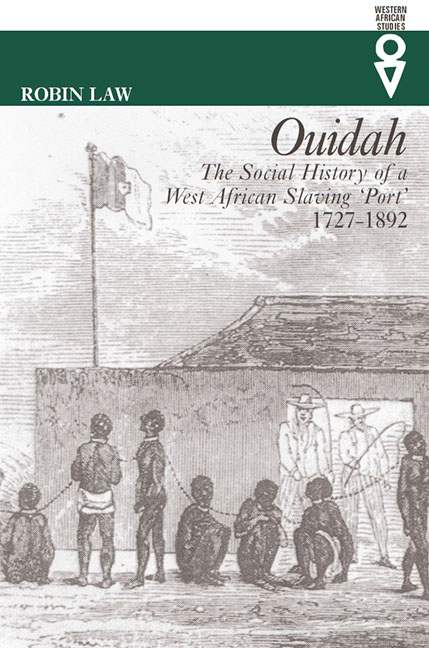Book contents
- Frontmatter
- Dedication
- Contents
- List of Maps & Tables
- Acknowledgements
- Abbreviations
- Map
- Introduction
- 1 Origins: Ouidah before the Dahomian conquest
- 2 The Dahomian Conquest of Ouidah
- 3 Dahomian Ouidah
- 4 The Operation of the Atlantic Slave Trade
- 5 De Souza's Ouidah The era of the illegal slave trade 1815 –39
- 6 The Era of Transition From slaves to palm oil 1840–57
- 7 Dissension & Decline Ouidah under King Glele 1858–77
- 8 From Dahomian to French Rule 1878-92
- Sources & Bibliography
- Index
- Frontmatter
- Dedication
- Contents
- List of Maps & Tables
- Acknowledgements
- Abbreviations
- Map
- Introduction
- 1 Origins: Ouidah before the Dahomian conquest
- 2 The Dahomian Conquest of Ouidah
- 3 Dahomian Ouidah
- 4 The Operation of the Atlantic Slave Trade
- 5 De Souza's Ouidah The era of the illegal slave trade 1815 –39
- 6 The Era of Transition From slaves to palm oil 1840–57
- 7 Dissension & Decline Ouidah under King Glele 1858–77
- 8 From Dahomian to French Rule 1878-92
- Sources & Bibliography
- Index
Summary
Ouidah is situated in the coastal area (in the Department of Atlantique) of the modern Republic of Benin (formerly the French colony of Dahomey) in West Africa. In origin, it is an indigenous African town, which had existed long before the French colonial occupation in 1892. In the pre-colonial period, it had belonged successively to two African states, first the kingdom of Hueda (whence the name ‘Ouidah’) and from 1727 that of Dahomey, from which the French colony took its name; and the first language of its inhabitants today remains Fon, the language of Dahomey, with French inherited from the colonial period as the superimposed official language of administration and education. Today, Ouidah has a population of around 25,000, which by modern standards is quite modest, and it is dwarfed by the two leading cities of southern Benin: the official capital Porto- Novo, 60 km to the east (with a population probably around 200,000), and the commercial centre and international port of Cotonou, 40 km to the east (perhaps approaching 1,000,000).
In the precolonial period, however, Ouidah was the principal commercial centre in the region and the second town of the Dahomey kingdom, exceeded in size only by the capital Abomey, 100 km inland. In particular, it served as a major outlet for the export of slaves for the trans-Atlantic trade. The section of the African coast on which Ouidah is situated, in geographical terms the Bight (or Gulf) of Benin, was known to Europeans between the seventeenth and nineteenth centuries as the ‘Slave Coast’, from its prominence as a source of supply for the Atlantic slave trade; and within this region Ouidah was by far the most important point of embarkation for slaves, far outshadowing its nearest rival, Lagos, 150 km to the east (in modern Nigeria). Ouidah was a leading slaving port for almost two centuries, from the 1670s to the 1860s. During this period, the Bight of Benin is thought to have accounted for around 22 per cent of all slaves exported to the Americas, and Ouidah for around 51 per cent of exports from the Bight.
- Type
- Chapter
- Information
- OuidahThe Social History of a West African Slaving Port 1727-1892, pp. 1 - 17Publisher: Boydell & BrewerPrint publication year: 2017

